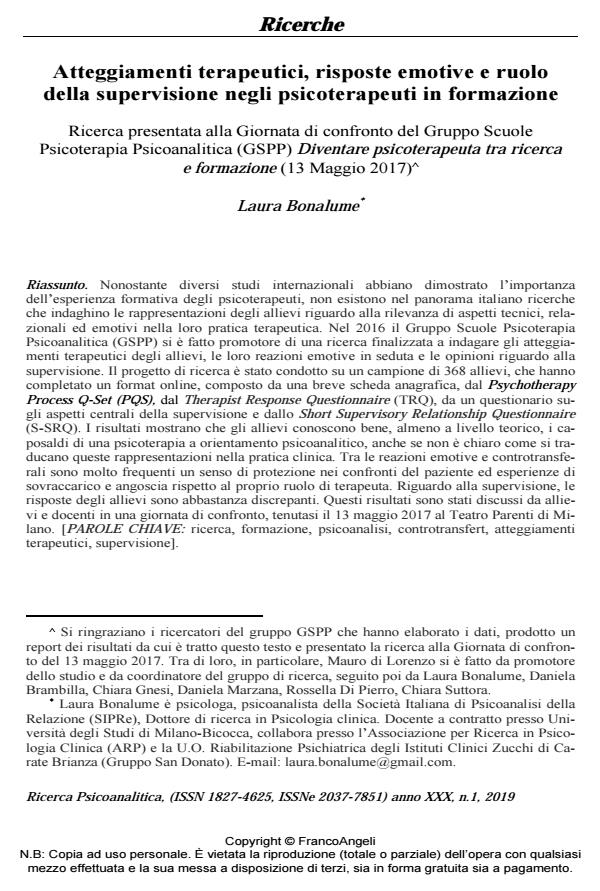Therapeutic attitudes, emotional responses and role of supervision according to therapists in training
Journal title RICERCA PSICOANALITICA
Author/s Laura Bonalume
Publishing Year 2019 Issue 2019/1
Language Italian Pages 22 P. 91-112 File size 308 KB
DOI 10.3280/RPR2019-001007
DOI is like a bar code for intellectual property: to have more infomation
click here
Below, you can see the article first page
If you want to buy this article in PDF format, you can do it, following the instructions to buy download credits

FrancoAngeli is member of Publishers International Linking Association, Inc (PILA), a not-for-profit association which run the CrossRef service enabling links to and from online scholarly content.
Research presented to the meeting of the schools of psychoanalytical psychotherapy (GSPP) held on May 13, 2017, Becoming a psychotherapist between research and training. Abstract. Despite the fact that various international studies have proved the importance of the training experience for psychotherapists, in Italy there have not been research papers examining the representations of candidates on the importance of technical, relational and emotional aspects in their therapeutic practice. In 2016 GSPP promoted a research aimed at studying the therapeutic attitudes of candidates, their emotional reactions in the session, and their opinions on supervision. This research project has been performed on a sample of 368 candidates who completed an online format made up of a brief summary of personal data, the Psychotherapy Process Q-Set (PQS), the Therapist Response Questionnaire (TRQ), a questionnaire on the central aspects of supervision and the Short Supervisory Relationship Questionnaire (S-SRQ). The results show that the candidates knew well, at least at theoretical level, the main tenets of psychoanalytically oriented psychotherapy, although it is not clear how these representations are translated into in clinical practice. Among emotional and countertransference reactions, the most frequent is a sense of protection towards the patient and experiences of overload and anxiety concerning one’s role as therapist. As far as supervision is concerned, candidates presented divergent answers. These results have been discussed by candidates and teachers in a meeting held on May 17, 2017 in Milan.
Keywords: Research, training, psychoanalysis, counter transference, therapeutic attitudes, supervision
- Developing a prototype for Psychoanalysis of Relationship therapy. An empirical study with the Psychotherapy Process Q-set Laura Bonalume, Laura Corbelli, Mattia Ferro, Anna Lisa Mazzoleni, Maria Pia Roggero , in Research in Psychotherapy: Psychopathology, Process and Outcome /2023
DOI: 10.4081/ripppo.2023.674
Laura Bonalume, Atteggiamenti terapeutici, risposte emotive e ruolo della supervisione negli psicoterapeuti in formazione Ricerca presentata alla Giornata di confronto del Gruppo Scuole Psicoterapia Psicoanalitica (GSPP) Diventare psicoterapeuta tra ricerca e formazione (13 Maggio 2017) in "RICERCA PSICOANALITICA" 1/2019, pp 91-112, DOI: 10.3280/RPR2019-001007